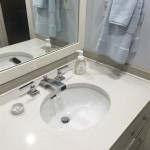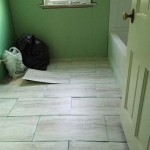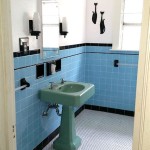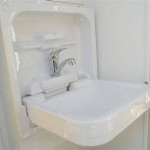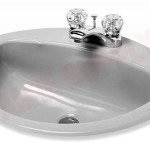How To Seal Granite Bathroom Countertops
Granite countertops are a popular choice for bathrooms due to their durability and aesthetic appeal. However, granite is a porous material, meaning it can absorb liquids and stains if not properly sealed. Sealing granite acts as a protective barrier, preventing water, oils, and other substances from penetrating the stone and causing damage or discoloration. This article provides a comprehensive guide on how to effectively seal granite bathroom countertops to ensure their longevity and maintain their beauty.
The frequency with which granite countertops need sealing depends on the type of granite and the sealing product used. Some granites are more porous than others and require more frequent sealing. Generally, it's recommended to seal granite countertops at least once a year, or more often if you notice water no longer beads up on the surface. Regular sealing is crucial in a bathroom environment where countertops are exposed to moisture and potentially staining substances like soap, makeup, and toothpaste.
Before beginning the sealing process, gathering the necessary materials is essential. These materials will ensure a smooth and effective application. Here’s a list of the required items:
- Granite Sealer: Choose a high-quality, penetrating granite sealer specifically designed for natural stone.
- Clean Microfiber Cloths: These are used for cleaning and applying the sealant.
- Spray Bottle (optional): Some sealers are designed to be sprayed on.
- Painter's Tape: To protect surrounding areas like backsplashes and sinks.
- Clean Bucket: For mixing cleaning solutions, if necessary.
- Mild Dish Soap (optional): For cleaning the countertop before sealing.
- Soft-bristled Brush (optional): Helpful for removing stubborn dirt.
Preparing the Granite Countertop
Proper preparation is paramount for a successful sealing. A clean and dry surface ensures the sealer can penetrate effectively and provide maximum protection. The preparation process involves thorough cleaning and drying of the granite countertop.
Firstly, thoroughly clean the granite countertop. Begin by removing all items from the countertop, including toiletries, soap dispensers, and decorative objects. Use a soft cloth or sponge to wipe away any loose dirt, debris, or spills. For general cleaning, a solution of mild dish soap and warm water works well. Avoid using abrasive cleaners, as they can damage the granite surface. If there are any stubborn stains, try using a granite-specific cleaner or a paste of baking soda and water. Apply the paste to the stain, let it sit for a few minutes, and then gently scrub with a soft brush before rinsing thoroughly.
Once cleaned, rinse the countertop thoroughly with clean water to remove any soap residue. Ensure no soap film remains, as this can interfere with the sealer's ability to bond properly with the granite. Use a clean, damp cloth to wipe down the surface multiple times, ensuring all traces of soap are gone. After rinsing, thoroughly dry the granite countertop with a clean, dry microfiber cloth. Pay attention to edges, corners, and areas around the sink, ensuring no moisture remains. Allow the countertop to air dry completely for at least 24 hours before applying the sealer. This ensures that any trapped moisture within the granite evaporates, allowing for optimal sealer penetration. This waiting period is crucial, especially in humid environments.
Finally, after the 24-hour drying period, inspect the countertop for any remaining residue or discoloration. If any issues are found, repeat the cleaning process as needed. Before proceeding to the sealing stage, apply painter's tape to protect surrounding areas, such as backsplashes, sinks, and walls. This will prevent the sealer from accidentally getting on surfaces where it isn't needed. Make sure the tape is securely applied to create a clean and even line.
Applying the Granite Sealer
After the countertop is thoroughly cleaned and dried, and surrounding areas are protected with painter's tape, the next step is to apply the granite sealer. This process involves carefully applying the sealer, ensuring proper coverage, and allowing it to penetrate the granite effectively.
Begin by carefully reading the manufacturer's instructions on the granite sealer product. Different sealers may have specific application instructions or recommendations, such as the number of coats, drying times, or application methods. Adhering to these instructions ensures optimal performance of the sealer. Next, prepare the sealer according to the instructions. Some sealers come ready to use, while others may need to be mixed or diluted. If using a spray bottle, pour the sealer into the bottle, ensuring it is clean and free of any contaminants. If applying with a cloth, have a clean microfiber cloth ready to use.
Apply the sealer evenly across the granite countertop. If using a spray bottle, spray a light, even coat of sealer onto the surface, working in small sections. Avoid oversaturating the countertop, as this can lead to pooling or uneven drying. If applying with a cloth, dampen the cloth with sealer and wipe it across the surface in smooth, overlapping strokes. Ensure that the entire countertop is covered, including edges, corners, and areas around the sink. Pay special attention to areas that are frequently exposed to moisture, such as around the faucet. After applying the first coat, allow the sealer to penetrate the granite for the recommended time, as specified in the manufacturer's instructions. This time allows the sealer to be absorbed into the stone's pores, providing protection against stains and water damage.
After the initial penetration time, apply a second coat of sealer, following the same procedure as the first coat. This ensures thorough coverage and maximum protection. Allow the second coat to penetrate for the recommended time as well. Once the final penetration time has elapsed, wipe away any excess sealer from the surface with a clean, dry microfiber cloth. This prevents the sealer from drying on the surface and leaving a sticky or hazy residue. Ensure that all excess sealer is removed, paying attention to edges and corners.
Post-Sealing Care and Maintenance
Once the granite countertop has been sealed, following proper care and maintenance procedures is crucial to prolong the effectiveness of the sealer and maintain the countertop's appearance. This involves allowing sufficient drying time, avoiding harsh chemicals, and regularly cleaning the surface.
Allow the sealed granite countertop to cure completely for the recommended time, as specified in the manufacturer's instructions. This curing time allows the sealer to fully bond with the granite and provide maximum protection. Avoid using the countertop or placing any items on it during the curing period. The duration of the curing period can vary, but it is generally recommended to wait at least 24 to 72 hours before using the countertop. After the curing period, remove the painter's tape from the surrounding areas, taking care not to damage the countertop surface. Inspect the sealed countertop for any imperfections or inconsistencies in the finish. If any issues are found, such as uneven coverage or sticky residue, consult the manufacturer's instructions or contact a professional for assistance.
For ongoing maintenance, clean the granite countertop regularly with a pH-neutral cleaner or a mild dish soap and water solution. Avoid using abrasive cleaners, acidic cleaners, or bleach, as these can damage the sealer and the granite surface. Wipe up spills immediately to prevent staining, especially acidic substances like lemon juice or vinegar. Place mats or trivets under hot pots and pans to prevent heat damage. Use cutting boards when preparing food to avoid scratching the countertop. Periodically reapply granite sealer as needed, typically every one to two years, or as recommended by the manufacturer. The frequency of resealing depends on the type of granite, the amount of use, and the effectiveness of the sealer. To test if the countertop needs resealing, pour a small amount of water onto the surface. If the water beads up, the sealer is still effective. If the water is absorbed into the granite, it's time to reseal.
By following these steps, sealing granite bathroom countertops will be a breeze, and your countertops will remain durable and beautiful for years to come. Proper preparation, careful application, and consistent maintenance are the keys to preserving the integrity and aesthetic appeal of your granite surfaces.

How To Seal Granite Vanity Top Eagle Stones Marble

How To Treat Seal Granite And Marble Countertops Lesher

Granite Paste Sealer How To Seal Eagle Stones Marble

How To Seal Granite Vanity Top Eagle Stones Marble

Three Rules For Proper Granite Bathroom Countertop Care

How To Install A Bathroom Countertop Pkb Cabinetry

How To Seal Granite Countertops Tips From Bob Vila

How To Seal Granite Countertop Step By Guide

How To Treat Seal Granite And Marble Countertops Lesher

How To Treat Seal Granite And Marble Countertops Lesher
